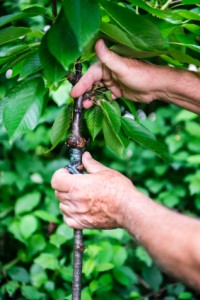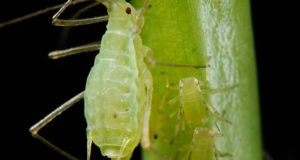 In this installment we will discuss the various types of layering, division, separation, grafting, and budding.
In this installment we will discuss the various types of layering, division, separation, grafting, and budding.
Layering
Plant stems, still attached to the parent, may form roots where they touch rooting medium. When severed from parent plant, the rooted stem becomes a new plant. This method is highly successful as it prevents the water stress and carbohydrate shortage that plague the various cutting methods. The rooting medium should provide aeration and a constant supply of moisture.
- Tip Layering – dig a hole three to four inches deep and insert a shoot tip. Cover with soil. The tip will grow downward first and then grow upwards. It will form roots at the bend, and the re-curved tip will become a new plant. Remove the new plant and plant it in early spring or late fall.
- Simple Layering – bend plant stem to the ground and cover a portion with soil, leaving the last six to twelve inches exposed. Bend tip vertical and stake in place. The sharp bend often induces rooting, but wounding the underside of the branch may enhance rooting.
- Mound (or Stool) Layering – cut plant to one inch above the ground when dormant; mound soil over the shoots in the spring to enhance rooting.
- Compound Layering – works well for plants with flexible stems. Bend the stem down to the rooting medium and alternately expose and cover the stem in sections. Wound the underside of the stem sections to be covered, as this will encourage rooting.
- Air Layering – this is used to propagate some indoor plants with thick stems or to rejuvenate them when they become leggy. Slit the stem just below a node and pry open the slit with a toothpick. Pack wet, unmilled sphagnum moss around the wound, wrap plastic around the moss and tie in place. When roots spread throughout the moss cut off the new plant just below root ball.
Division
Division may be thought of as a modification of layering, because the new plants are formed before they are detached from their parent plants.
- Stolon – a horizontal, often fleshy, stem that can form roots, then produce new shoots where it touches the growing medium.
- Runners – slender stems that originate in a leaf axil and grow along the ground, or downward from a hanging planter, making a new plant at its tip. Cutting the plantlets from stems of the parent plants’ stems propagates them. Plantlets that form at the tips of runners can be rooted while still attached to their parent plant by placing in a growing/rooting medium. Otherwise they are detached and placed in a rooting/growing medium.
- Offsets – are formed by plants with a rosetted stem. New shoots form at their base or in their leaf axils. Sever the new shoots from the parent plant after they form roots. Unrooted offsets of some species can be removed and placed in a growing medium. Some must be cut off, while others may be lifted from the parent plant’s stem.
Separation
Separation is a term applied to the propagation of plants that produce bulbs or corms that multiply.
- Bulbs – new bulbs grow beside the ones originally planted. They should be separated every three to five years to allow the largest blooms and to increase your bulb population. Dig up the clump after the leaves have withered. Gently pull the bulbs apart and replant immediately so their roots can begin to develop. Small bulbs may not flower for two to three years, but the larger ones should bloom the first season after separation.
- Corms – large, new corms form on top of old corms and tiny cormels form around the large corm. Dig up corms after leaves wither and allow them to dry in indirect sunlight for two to three weeks. Remove cormels, and then gently separate old corms from new ones. Dust all of the new corms with an organic fungicide and store in a cool, dry place until planting.
- Crowns – plants with more than one rooted crown may be divided and planted separately. If stems are not joined, gently pull apart; if crowns are united by horizontal stems, cut stems and roots with a sharp knife to minimize injury. Divisions of some outdoor plants should be dusted with an organic, chemical-free fungicide before replanting.
Grafting and Budding
Both grafting and budding are methods of propagation that join parts of two different plants so that they will grow as one. They are used for propagating cultivars that don’t root well as cuttings or whose original root system is inadequate. You can add one or more new cultivars to existing fruit and nut trees using these methods. The portion to be propagated is called the scion, consisting of a piece of shoot with dormant buds that will produce a stem and branches. The rootstock will provide the new plants root system and sometimes the lower portion of the stem.
When the scion is grafted onto the rootstock the cambium (a layer of cells located between the stem’s xylem and phloem) of the two must touch. New xylem and phloem cells will originate from the cambial tissues. Four conditions must also be met for successful grafting:
- Rootstock and scion must be compatible
- Each plant must be at the proper developmental stage
- The cambial layers of rootstock and scion must meet
- Graft union must be kept moist until the wound heals
Cleft Grafting – is most often used to change the cultivar or top growth of a shoot or young tree, usually a seedling. It can be especially successful done in early spring. Collect scion wood that is 3/8 to 5/8 inch in diameter. Cut a limb or small trunk of the tree for the rootstock perpendicular to its length. Make a two-inch vertical cut through the center of the first cut, being careful not to tear the tender bark. Use a small wedge to keep this cut open.
Prepare two scion pieces three to four inches long. Cut lower end of each scion piece into a wedge; insert the scions at the outer edges of the cut in the stock. Tilt the scions’ tops slightly outward to ensure cambial layers of the scions and rootstock touch. Remove the wedge that is keeping the slit open and cover all cut surfaces with grafting wax. When grafting, cut back all of the limbs of rootstock. Also, as the new cultivar increases in leafing out, gradually reduce the leafage of old cultivar. Over the next two years, the new one should completely take over. Removing the foliage from old cultivar all at once will greatly increase the chances of shock for your grafting and causes excessive suckering. The scions may also grow too fast, causing them to be susceptible to wind damage, so go slow.
Bark Grafting – this can be preformed on large limbs, unlike most grafting methods. Collect scion wood that is 3/8 to 1/2-inch in diameter when the plant is dormant; wrap wood in moist paper toweling and place inside a plastic bag in your refrigerator. Saw off a limb or the trunk of the rootstock at right angle to itself. In spring, when it is easiest to separate the bark from the wood, make a ½-inch diagonal cut on one side of scion and 1- to 1½-inch cut on the other side. Leave two buds above the longer cut. Cut through bark of rootstock a little wider than the scion. Remove the top third of the bark from this cut area and insert the scion with longer cut against the wood. Nail graft in place with flat-headed, wire nails and cover all wounds with grafting wax. Cut back selected limbs of old cultivar as described under cleft grafting.
Whip or Tongue Grafting – often used for material that is ¼ to ½ inch in diameter. The rootstock and scion are usually the same diameter; however, the scion may be narrower. This is a strong graft type, as it heals quickly and provides excellent cambial coverage. Make one diagonal cut, 2½ inches long, at the top of the rootstock and a matching cut on the bottom of the scion. On the cut surface, make a slice downward into the rootstock and a matching one up into the scion so that pieces will interlock. Fit pieces together, tie the splice, and cover the union with grafting wax.
Care of Grafts
Two to three weeks after preparing grafts, inspect wax for cracking and rewax if cracks are present. After this, the graft should be strong enough that no further waxing should be needed. If using strong cord or grafting tape, cut it shortly after new growth appears to prevent girdling and possible death to new cultivar. Rubber budding strips have small advantage over other materials, as they expand with growth. They do not need to be cut because they will deteriorate and break with time.
Budding
Budding is the union of a rootstock with a scion containing a small piece of bark and one bud. It is useful when scion material is limited. It forms a stronger union and heals faster than grafts. It is common in the propagation of roses.
- Patch budding – plants with thick bark should be patch budded while plants are actively growing so bark can be easily slipped. Remove a rectangular section of bark from the rootstock and cover this wound with a bud or a matching bit of bark from the scion. If the bark of the rootstock is thicker than the bark of the scion, pare it down to meet the thinner bark so that the patch will be held firmly in place when wrapped to cover the wound.
- Chip budding – is used when the bark is not slipping. Slice downward into the rootstock at 45° angle through ¼ of the wood. Make a second cut one inch above the first cut. Remove a bud with a chip of bark and wood to fit the wound in the rootstock. Fit the chip into the wound and wrap the union with budding strips.
- T-budding – the most commonly used budding method. When bark is slipping, make a vertical cut (same axis as the rootstock’s bark) through the rootstock’s bark. At the top of this cut, make a horizontal cut (forming the T) and loosen the bark by twisting the knife in the intersection. Avoid any buds while making cuts. Remove a shield-shaped piece, including a bud, bark, and a thin section of wood from the scion material. Push the shield section under the loosened bark of the rootstock; wrap the union, leaving the bud exposed.
Care of Buds
Make bud grafts in August. Next spring, force buds to develop by removing the stock three to four inches above union; tie the new shoot to the stub to prevent wind damage. When the union is proven strong, cut the stub off close to the budded area.
For more information, including which plants respond best to each type of propagation, visit the links below:
https://www.mastergardenproducts.com/gardenerscorner/new_page_4.htm
https://www.uaf.edu/ces/districts/tanana/mg/manual/chapters/4-Plant-Propagation.pdf
©2012 Off the Grid News
 Off The Grid News Better Ideas For Off The Grid Living
Off The Grid News Better Ideas For Off The Grid Living



